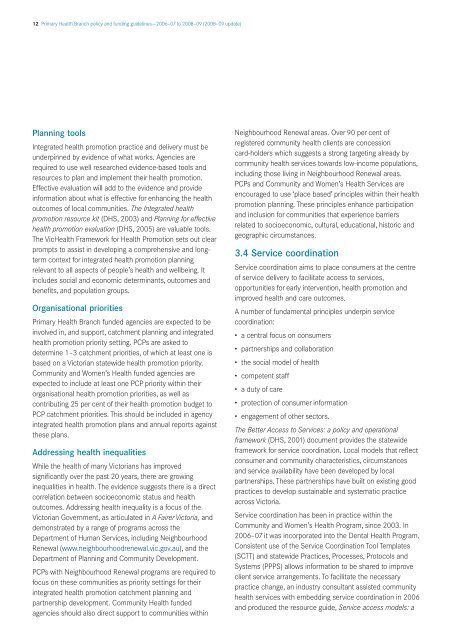Primary Health Branch policy and funding guidelines
Primary Health Branch policy and funding guidelines
Primary Health Branch policy and funding guidelines
Create successful ePaper yourself
Turn your PDF publications into a flip-book with our unique Google optimized e-Paper software.
12 <strong>Primary</strong> <strong>Health</strong> <strong>Branch</strong> <strong>policy</strong> <strong>and</strong> <strong>funding</strong> <strong>guidelines</strong>––2006–07 to 2008–09 (2008–09 update)<br />
Planning tools<br />
Integrated health promotion practice <strong>and</strong> delivery must be<br />
underpinned by evidence of what works. Agencies are<br />
required to use well researched evidence-based tools <strong>and</strong><br />
resources to plan <strong>and</strong> implement their health promotion.<br />
Effective evaluation will add to the evidence <strong>and</strong> provide<br />
information about what is effective for enhancing the health<br />
outcomes of local communities. The Integrated health<br />
promotion resource kit (DHS, 2003) <strong>and</strong> Planning for effective<br />
health promotion evaluation (DHS, 2005) are valuable tools.<br />
The Vic<strong>Health</strong> Framework for <strong>Health</strong> Promotion sets out clear<br />
prompts to assist in developing a comprehensive <strong>and</strong> longterm<br />
context for integrated health promotion planning<br />
relevant to all aspects of people’s health <strong>and</strong> wellbeing. It<br />
includes social <strong>and</strong> economic determinants, outcomes <strong>and</strong><br />
benefits, <strong>and</strong> population groups.<br />
Organisational priorities<br />
<strong>Primary</strong> <strong>Health</strong> <strong>Branch</strong> funded agencies are expected to be<br />
involved in, <strong>and</strong> support, catchment planning <strong>and</strong> integrated<br />
health promotion priority setting. PCPs are asked to<br />
determine 1–3 catchment priorities, of which at least one is<br />
based on a Victorian statewide health promotion priority.<br />
Community <strong>and</strong> Women’s <strong>Health</strong> funded agencies are<br />
expected to include at least one PCP priority within their<br />
organisational health promotion priorities, as well as<br />
contributing 25 per cent of their health promotion budget to<br />
PCP catchment priorities. This should be included in agency<br />
integrated health promotion plans <strong>and</strong> annual reports against<br />
these plans.<br />
Addressing health inequalities<br />
While the health of many Victorians has improved<br />
significantly over the past 20 years, there are growing<br />
inequalities in health. The evidence suggests there is a direct<br />
correlation between socioeconomic status <strong>and</strong> health<br />
outcomes. Addressing health inequality is a focus of the<br />
Victorian Government, as articulated in A FairerVictoria, <strong>and</strong><br />
demonstrated by a range of programs across the<br />
Department of Human Services, including Neighbourhood<br />
Renewal (www.neighbourhoodrenewal.vic.gov.au), <strong>and</strong> the<br />
Department of Planning <strong>and</strong> Community Development.<br />
PCPs with Neighbourhood Renewal programs are required to<br />
focus on these communities as priority settings for their<br />
integrated health promotion catchment planning <strong>and</strong><br />
partnership development. Community <strong>Health</strong> funded<br />
agencies should also direct support to communities within<br />
Neighbourhood Renewal areas. Over 90 per cent of<br />
registered community health clients are concession<br />
card-holders which suggests a strong targeting already by<br />
community health services towards low-income populations,<br />
including those living in Neighbourhood Renewal areas.<br />
PCPs <strong>and</strong> Community <strong>and</strong> Women’s <strong>Health</strong> Services are<br />
encouraged to use ‘place based’ principles within their health<br />
promotion planning. These principles enhance participation<br />
<strong>and</strong> inclusion for communities that experience barriers<br />
related to socioeconomic, cultural, educational, historic <strong>and</strong><br />
geographic circumstances.<br />
3.4 Service coordination<br />
Service coordination aims to place consumers at the centre<br />
of service delivery to facilitate access to services,<br />
opportunities for early intervention, health promotion <strong>and</strong><br />
improved health <strong>and</strong> care outcomes.<br />
A number of fundamental principles underpin service<br />
coordination:<br />
• a central focus on consumers<br />
• partnerships <strong>and</strong> collaboration<br />
• the social model of health<br />
• competent staff<br />
• a duty of care<br />
• protection of consumer information<br />
• engagement of other sectors.<br />
The Better Access to Services: a <strong>policy</strong> <strong>and</strong> operational<br />
framework (DHS, 2001) document provides the statewide<br />
framework for service coordination. Local models that reflect<br />
consumer <strong>and</strong> community characteristics, circumstances<br />
<strong>and</strong> service availability have been developed by local<br />
partnerships. These partnerships have built on existing good<br />
practices to develop sustainable <strong>and</strong> systematic practice<br />
across Victoria.<br />
Service coordination has been in practice within the<br />
Community <strong>and</strong> Women’s <strong>Health</strong> Program, since 2003. In<br />
2006–07 it was incorporated into the Dental <strong>Health</strong> Program.<br />
Consistent use of the Service Coordination Tool Templates<br />
(SCTT) <strong>and</strong> statewide Practices, Processes, Protocols <strong>and</strong><br />
Systems (PPPS) allows information to be shared to improve<br />
client service arrangements. To facilitate the necessary<br />
practice change, an industry consultant assisted community<br />
health services with embedding service coordination in 2006<br />
<strong>and</strong> produced the resource guide, Service access models: a

















